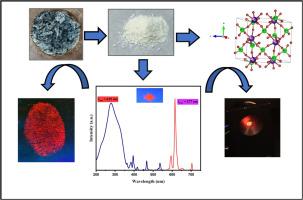Eu3+ substituted Y2Mo4O15 nanophosphors for latent fingerprint detection and pc-LED applications
IF 5.7
3区 材料科学
Q2 MATERIALS SCIENCE, MULTIDISCIPLINARY
引用次数: 0
Abstract
A series of Eu3+ substituted nanophosphors was successfully synthesized through combustion method. The structural details of the nanophosphors were confirmed through X-ray diffraction and vibrational spectroscopic studies. These studies reveal that the compounds exist in monoclinic structure with space group . The optical properties of the nanophosphors were explored through diffuse reflectance spectroscopy and photoluminescence studies. Under the excitation of near UV light, Eu3+ substituted phosphors showed emission in the red region. The intensity of red emission was tuned by varying the Eu3+ concentration and the maximum emission intensity was obtained at . The luminescence lifetime, correlated color temperature, color purity, chromaticity coordinates and quantum yield measurements suggested that the prepared nanophosphors are promising candidates for luminescence applications. Accordingly, the suitability of the optimized nanophosphor for detection of latent fingerprints and phosphor converted light emitting diode applications was investigated.

Eu3+取代Y2Mo4O15纳米荧光粉用于潜在指纹检测和pc-LED应用
采用燃烧法制备了一系列Eu3+取代的Y2Mo4O15纳米荧光粉。通过x射线衍射和振动光谱研究证实了纳米荧光粉的结构细节。这些研究表明化合物以单斜斜结构存在,空间群为P21/c。通过漫反射光谱和光致发光研究探讨了纳米荧光粉的光学性质。在近紫外光的激发下,Eu3+取代的Y2Mo4O15荧光粉在红色区域有发光。通过改变Eu3+的浓度来调整红光发射强度,在x=0.5处获得最大发射强度。发光寿命、相关色温、色纯度、色度坐标和量子产率的测量结果表明,所制备的纳米荧光粉具有较好的发光应用前景。因此,研究了优化后的纳米荧光粉在潜在指纹检测和荧光粉转换发光二极管应用中的适用性。
本文章由计算机程序翻译,如有差异,请以英文原文为准。
求助全文
约1分钟内获得全文
求助全文
来源期刊

Materials Research Bulletin
工程技术-材料科学:综合
CiteScore
9.80
自引率
5.60%
发文量
372
审稿时长
42 days
期刊介绍:
Materials Research Bulletin is an international journal reporting high-impact research on processing-structure-property relationships in functional materials and nanomaterials with interesting electronic, magnetic, optical, thermal, mechanical or catalytic properties. Papers purely on thermodynamics or theoretical calculations (e.g., density functional theory) do not fall within the scope of the journal unless they also demonstrate a clear link to physical properties. Topics covered include functional materials (e.g., dielectrics, pyroelectrics, piezoelectrics, ferroelectrics, relaxors, thermoelectrics, etc.); electrochemistry and solid-state ionics (e.g., photovoltaics, batteries, sensors, and fuel cells); nanomaterials, graphene, and nanocomposites; luminescence and photocatalysis; crystal-structure and defect-structure analysis; novel electronics; non-crystalline solids; flexible electronics; protein-material interactions; and polymeric ion-exchange membranes.
 求助内容:
求助内容: 应助结果提醒方式:
应助结果提醒方式:


